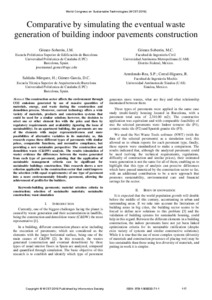Mostra el registre d'ítem simple
Comparative by simulating the eventual waste generation of building indoor pavements construction
| dc.contributor.author | Gómez Soberón, José Manuel Vicente |
| dc.contributor.author | Gómez Soberón, M. Consolación |
| dc.contributor.author | Saldaña Márquez, Héctor |
| dc.contributor.author | Gámez García, Diana C. |
| dc.contributor.author | Arredondo Rea, Susana Paola |
| dc.contributor.author | Corral Higuera, Ramón |
| dc.contributor.other | Universitat Politècnica de Catalunya. Departament de Construccions Arquitectòniques II |
| dc.contributor.other | Universitat Politècnica de Catalunya. Departament de Tecnologia de l'Arquitectura |
| dc.date.accessioned | 2017-02-21T11:46:41Z |
| dc.date.available | 2017-02-21T11:46:41Z |
| dc.date.issued | 2016 |
| dc.identifier.citation | Gómez-Soberón, J.M., Gómez, M. C., Saldaña , H., Gámez, D., Arredondo-Rea, S.P., Corral, R. Comparative by simulating the eventual waste generation of building indoor pavements construction. A: World Congress on Sustainable Technologies. "Proceedings World Congress on Sustainable Technologies (WCST-2016)". Londres: 2016, p. 117-121. |
| dc.identifier.isbn | 978-1-908320-71-1 |
| dc.identifier.uri | http://hdl.handle.net/2117/101305 |
| dc.description.abstract | The construction sector affects the environment through CO2 emissions generated by use of massive quantities of materials, energy, and waste during the construction and demolition process. Moreover, current technology offers a wide variety of materials, products and construction systems that could be used for a similar solution; however, the decision to select one or other element lies with the price and then by regulatory requirements and availability (ignoring the issue of sustainability). In an apartment building, the pavements are one of the elements with major representativeness and more possibilities of alternative variables in its materials; so, this research expose three different types of pavements with similar prices, comparable functions, and normative compliance, but providing a new sustainable perspective: The construction and demolition waste (C&DW) analysis. The results (simulation of waste) evidence the differences between the wastes generated from each type of pavement, pointing that the application of sustainable management criteria can be significant for sustainable buildings construction. This research shows a new criterion applicable to the construction sector that could improve the selection (with equal requirements) of one type of pavement into a more environmentally friendly pavement, allowing the achievement of profits for the builders. ______________ El sector de la construcción afecta al medio ambiente a través de las emisiones de CO2 generadas por el uso de cantidades masivas de materiales, energía y residuos durante el proceso de construcción y demolición. Además, la tecnología actual ofrece una amplia variedad de materiales, productos y sistemas de construcción que podrían utilizarse para una solución similar; Sin embargo, la decisión de seleccionar uno u otro elemento radica en el precio y luego en los requisitos reglamentarios y la disponibilidad (ignorando la cuestión de la sostenibilidad). En un edificio de apartamentos, las aceras son uno de los elementos con mayor representatividad y más posibilidades de variables alternativas en sus materiales; Por lo que esta investigación expone tres tipos diferentes de pavimentos con precios similares, funciones comparables y cumplimiento normativo, pero aportando una nueva perspectiva sostenible: el análisis de residuos de construcción y demolición (C & DW). Los resultados (simulación de residuos) evidencian las diferencias entre los residuos generados por cada tipo de pavimento, señalando que la aplicación de criterios de gestión sostenible puede ser significativa para la construcción de edificios sostenibles. Esta investigación muestra un nuevo criterio aplicable al sector de la construcción que podría mejorar la selección (con iguales requisitos) de un tipo de pavimento en un pavimento más respetuoso con el medio ambiente, permitiendo el logro de beneficios para los constructores. |
| dc.format.extent | 5 p. |
| dc.language.iso | eng |
| dc.rights.uri | http://creativecommons.org/licenses/by-nc-nd/3.0/es/ |
| dc.subject | Àrees temàtiques de la UPC::Edificació::Elements constructius d'edificis::Elements d'acabat |
| dc.subject | Àrees temàtiques de la UPC::Edificació::Construcció sostenible |
| dc.subject.lcsh | Sustainable construction |
| dc.subject.other | building pavements |
| dc.subject.other | material selection criteria in construction |
| dc.subject.other | selection of sustainable materials |
| dc.subject.other | sustainable construction |
| dc.subject.other | waste simulation / Construcción de pavimentos |
| dc.subject.other | Criterios de selección de materiales en la construcción |
| dc.subject.other | Selección de materiales sostenibles |
| dc.subject.other | construcción sostenible |
| dc.subject.other | Simulación de residuos |
| dc.title | Comparative by simulating the eventual waste generation of building indoor pavements construction |
| dc.type | Conference report |
| dc.subject.lemac | Construcció sostenible |
| dc.subject.lemac | Pavi |
| dc.contributor.group | Universitat Politècnica de Catalunya. GICITED - Grup Interdiciplinari de Ciència i Tecnologia en l'Edificació |
| dc.identifier.dl | CFP1680P-USB |
| dc.rights.access | Open Access |
| local.identifier.drac | 19682686 |
| dc.description.version | Postprint (published version) |
| local.citation.author | Gómez-Soberón, J.M.; Gómez, M. C.; Saldaña, H.; Gámez, D.; Arredondo-Rea, S.P.; Corral, R. |
| local.citation.contributor | World Congress on Sustainable Technologies |
| local.citation.pubplace | Londres |
| local.citation.publicationName | Proceedings World Congress on Sustainable Technologies (WCST-2016) |
| local.citation.startingPage | 117 |
| local.citation.endingPage | 121 |



